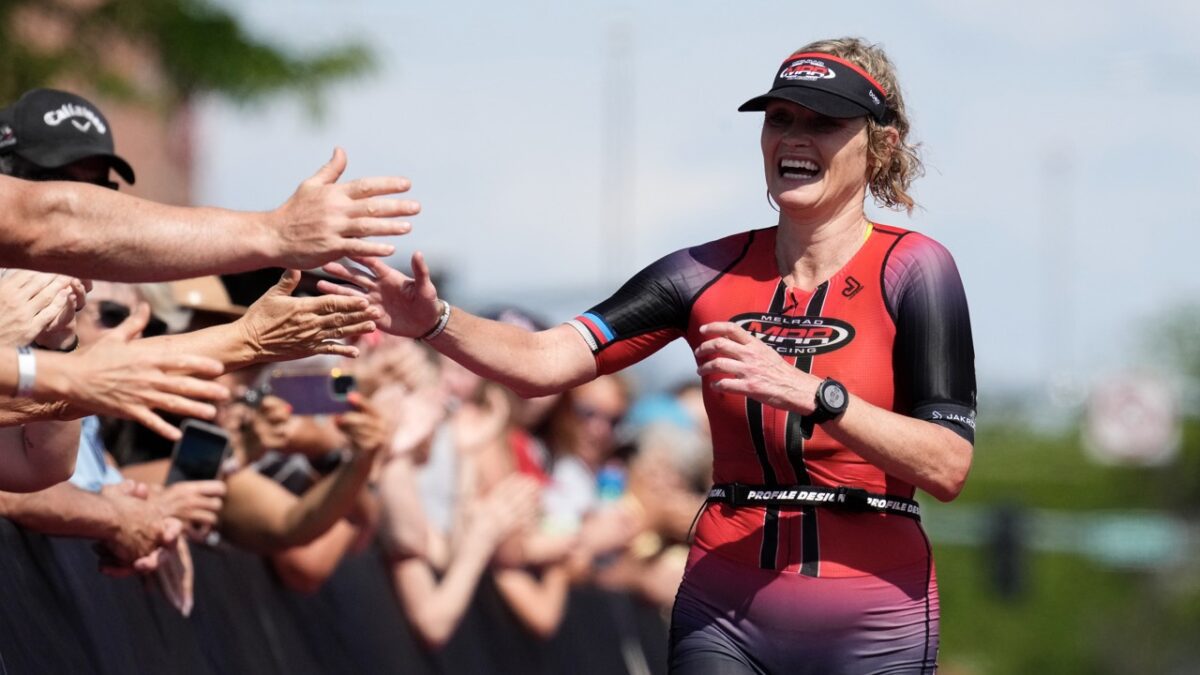6 Rules for improving your triathlon times after 40
Age is just a number - find out how you can go faster as you age up
 Photo by:
Patrick McDermott/Getty Images for Ironman
Photo by:
Patrick McDermott/Getty Images for Ironman
More and more professional athletes are challenging the notion that being over 40 is a time of decline in performance. In women’s marathon, elite runners Malindi Elmore and Natasha Wodak are setting personal best times in their 40s. (Editor’s note – shortly after she wrote this column, the author, pictured above, became the oldest woman to qualify for the Ironman World Championship as a pro!) Performance gains are available past the age of 40 in endurance racing if athletes adopt good training habits and follow these training rules.
Rule #1: Stay Healthy
This is the golden rule. Every rule that follows is meant to reinforce Rule #1. It takes longer to heal and recover from injuries and illness, so managing health is the most important deliverable for older athletes. Letting the athlete determine readiness for training (basically listening to your body), conservative loading decisions and good general health habits supporting recovery all support consistent training. Healthy athletes do more training, while that consistency creates great results.
Rule #2: Strength Is Speed
Strong athletes are fast. Rule #2 is basically insurance for Rule #1. Either make time for resistance training, or time for therapy rehabilitating a repetitive stress injury. Strength training creates resilience in a variety of tissues in the body and can support mobility and recovery.
The composition of your strength training session depends on athlete training age in weight training. New athletes with less than one to two years of experience benefit from push, pull, squat and hinge exercises with body weight. Experienced athletes with good technique can use heavier loading in training.
Strength improves the capacity to create force that is translated into speed. Strength also resists speed degradation in later stages of the race, making overall speed faster. Strong athletes are ultimately the fastest over longer distances, so it is a key deliverable for long course racing.
Rule #3: Speed Is Strength
Obeying Rule #2, sport-specific speedwork is a maximum strength stimulus important for triathlon training. In this instance, maximum speed is the objective, and the intervals are between 5 and 20 seconds maximum.
Speed is a quality that degrades quickly and requires good technique (see Rule #4). Implementing speed work in all three disciplines is important.
Speed for swimming is the safest to implement. Floating in the water has zero impact stress. The main limiter to most triathlon swimmers is threshold capacity, not necessarily speed. Speed work contributes durability and turnover improvements to your stroke. Short, 10- to 12-stroke maximum sprints help build speed in the pool. A small set of 8 x 25 m at the end of your swim sets is enough to tick this box.
Sprinting on the bike is never going to be specifically useful in a triathlon, but, as a maximum strength deliverable, it improves durability and fatigue resistance. Maximum strength also improves sustainable threshold power. Finally, using sprints late in a long ride is a great way to build the ability to finish strong on the bike in a triathlon.
Run sprints, in tandem with the work you do in the gym, improves the maximum strength capacity for run specific tissues. Short 10- to 20-second sprints not only build strength and stiffness in your tendons, but also reduce ground contacts and improve your economy over longer distances.
This type of work should be sprinkled into your training like cayenne pepper in a soup, carefully and deliberately. You can use sprinting on fresh legs for speed, along with sprints in a long run for fatigue resistance. To get the maximum benefit from Rule #3, you must obey Rule #4.
Rule #4: Technique Rules
Understanding any technical limiters in all three triathlon disciplines informs where major opportunities to improve exist. If you are having trouble maintaining consistency in your training because you get injured regularly, it can be a technical flaw. After 40, the body becomes less effective at compensation and injuries crop up. Fixing the problem is important.
When technical issues exist, injuries can be most problematic in running. There is an assumption that running is simple and instinctual, but that is only true for a lucky few. Most must learn good technique. Using a good coach, just as for swimming, can improve injury resistance and, in many cases, also improves speed potential.
This technical advice holds true for your swimming, weight training, aerodynamics, and mountain biking. Technical coaching makes a difference in all these disciplines. Athletes without bike handling skills have poor bike splits when the course isn’t in a straight line. There are numerous examples where paying attention to technical deficiency can be a game changer for older athletes.

Rule #5: Minimum Effective Dose
Rule #5 states training is performed without unnecessary strain. This principle should be applied both to overall programming and in daily training sessions. The training objective is hitting the targeted stimulus while remaining mindful of the next session. Usually there should be at least one repeat left in the tank in any given workout.
One example of adhering to this philosophy is for an extended run tempo session. This is a specific training zone for long course triathletes, but long high zone 3 to zone 4 sessions create high stress from both a muscular and neuromuscular perspective. Reducing the strain from this work, while still getting desired threshold stimulus, is key. Deliberate progression of these sessions helps manage the overall stress. These sessions build by increasing both the length of the workouts, and breaking the hard efforts with active rest. That helps build capacity without risk of breaking down. For example, for 12- to 20-minutes of tempo work, do four sets of five to eight minutes with a minute active jogging rest instead of 20 minutes straight. The physical adaptation is the same, but the strain both mentally and physically from that session is a lot less.
Rule #6: Recover Hard
Building an overall program that respects the above rules starts with knowing how much training the athlete can absorb. The amount of recovery needed from sessions is related to current level of fitness, not necessarily age. Listening to your body becomes more and more important the older you are. Using active recovery to space sessions out a little more might be required. Remembering Rule #1, a conservative training program that allows consistency is better than any single workout.
Strength training also maximizes recovery. Short sessions of lighter weight create a favorable hormonal response for recovery. Since hormones are part of the reason recovery is slower as you get older, using short sessions on recovery days, or even after a hard workout for an endocrine response, helps speed up recovery between training sessions.
There is so much to learn and practice in the journey of mastering triathlon which is why it is such a fun, challenging, lifelong sport. Following these rules for maintaining consistency is the key to maximizing performance beyond the age of 40.
Melanie McQuaid is the first 50-year-old to qualify for the Ironman World Championship as a professional. You can find out more about her and her coaching business here.
